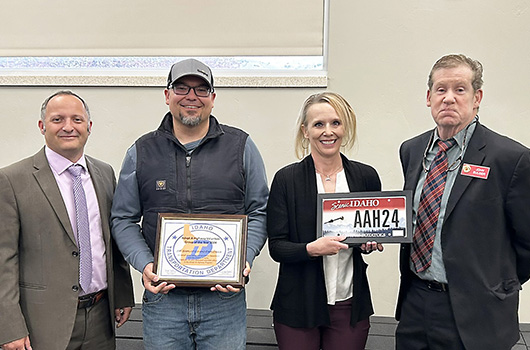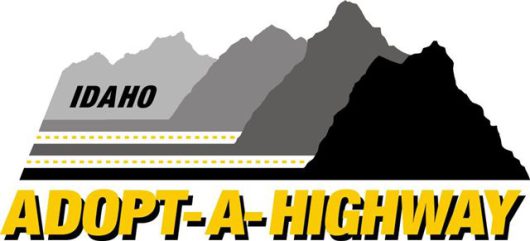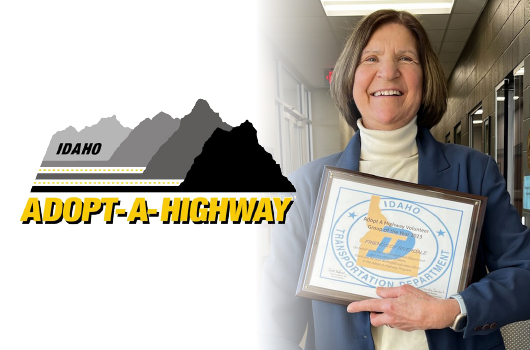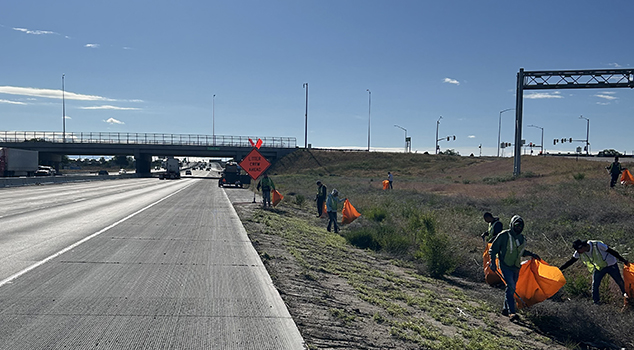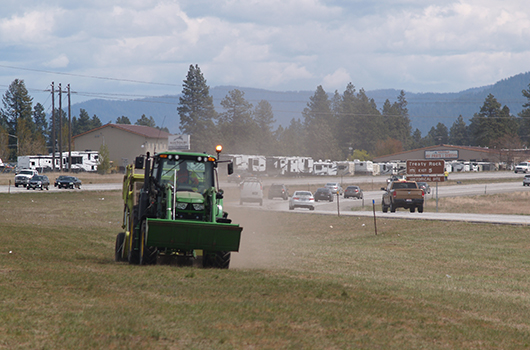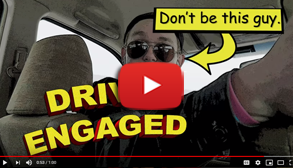Road Maintenance
Activities for Volunteer
Volunteer Services Program
 Idaho is a beautiful state and many citizens volunteer their time to maintain Idaho’s roadways.
Idaho is a beautiful state and many citizens volunteer their time to maintain Idaho’s roadways.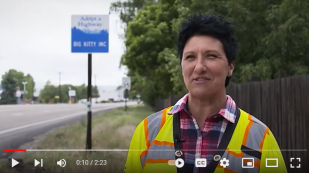
The Idaho Transportation Department (ITD) Volunteer Services Program allows individuals or groups to volunteer in ITD-approved activities in addition to the Adopt-A-Highway Program. The activities may include wildflower planting, wildlife fence maintenance, dispensing refreshments to the motoring public at select rest areas, or suggest your ideas on how you might like to volunteer.
- Click to see available Adopt-A-Highway routes & to register for this program
- Map of Idaho – ALL highways & mileposts (mile point)
Specific information about each program can be found under the topics below, as well as how to apply and participate in the various activities.
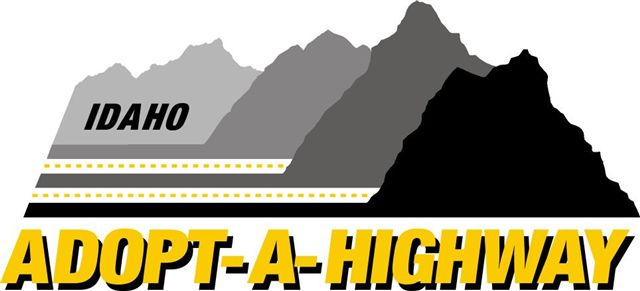 The Idaho Adopt-A-Highway program originated in 1990 as part of Idaho’s Centennial Celebration. Volunteer groups commit to pick up litter along a two-mile stretch of highway twice yearly and deposit it in bags provided by ITD. The Idaho Transportation Department maintenance crews gather the bagged litter for disposal.
The Idaho Adopt-A-Highway program originated in 1990 as part of Idaho’s Centennial Celebration. Volunteer groups commit to pick up litter along a two-mile stretch of highway twice yearly and deposit it in bags provided by ITD. The Idaho Transportation Department maintenance crews gather the bagged litter for disposal.
Volunteer groups are recognized for their service to the community with signage posted at the beginning of their chosen road segment. There is no cost to participate in the program. ITD supplies the group with loaned safety vests, trash bags and highway signage advising traffic there is a litter pick up activity currently underway on the roadside. Over the years, the Adopt-a-Highway program has accounted for millions of dollars in savings that were then redirected to highway construction and needed maintenance to improve highways and bridges.
ITD estimates the Adopt-A-Highway Program saves approximately $750,000 annually. There are more than 1,000 active volunteer groups participating in the statewide program. More than half of Idaho’s highways have been adopted but there are still many highway segments available for adoption.
To see currently available road segments go to:
- Adopt-A-Highway available routes | Map of Idaho – ALL highways & mileposts (mile point)
- Instructions for registering online for the Adopt-A-Highway Program
- To join the Adopt-A-Highway Program CLICK to register online
- If you prefer mailable forms, please go to the Documents/Forms tab above.
*NOTE: Although we make every effort to provide accurate road segment availability, applications are approved throughout the week and availability changes.
For additional information about the Adopt-a-Highway program, please email AdoptAHighway@itd.idaho.gov
 Through the Adopt-A-Wildlife Fence Maintenance program volunteers have the opportunity to support the efforts of the Idaho Transportation Department (ITD) and the Idaho Department of Fish and Game (IDFG) to minimize vehicle-wildlife collisions, increase the safety of the travelling public and Idaho’s wildlife by having volunteers assist with inspecting, and completing minor maintenance repairs to adopted segments of highway wildlife barrier fencing and reporting the need for major repairs to the Idaho Transportation Department.
Through the Adopt-A-Wildlife Fence Maintenance program volunteers have the opportunity to support the efforts of the Idaho Transportation Department (ITD) and the Idaho Department of Fish and Game (IDFG) to minimize vehicle-wildlife collisions, increase the safety of the travelling public and Idaho’s wildlife by having volunteers assist with inspecting, and completing minor maintenance repairs to adopted segments of highway wildlife barrier fencing and reporting the need for major repairs to the Idaho Transportation Department.
Adopt-A-Wildlife Fence volunteer efforts include twice yearly inspection, brush removal, minor repairs and litter pickup to designated parts of ITD owned wildlife fencing. At this time this program is limited to US-30 mileposts 371 to 378 and I-15 Mileposts 58.5 to 63.5.
If you or your organization would like to participate in this program, please visit the Documents/Forms tab above for the application and related forms.
Contact
Judi Conner | Judi.Conner@itd.idaho.gov | 208-334-8094
PO Box 7129| Boise, Idaho 83707

Through the Operation Wildflower Program, individuals and groups have the opportunity to volunteer in ITD-approved wildflower planting on certain approved highway sections.
- Spread the word about spreading wildflower seeds | “The Transporter” article
If you or your organization would like to participate in this program please view our Operation Wildflower Program Packet. For additional Operation Wildflower forms please visit the Documents/Forms tab above.
The Rest Area Activities Program allows nonprofit groups to dispense free refreshments to the motoring public for the purpose of providing a period of relaxation and improving highway safety.
If you or your organization would like to participate in this program please view our Rest Area Activities Program Packet. For additional forms please visit the Documents/Forms tab above.
District 1: North Idaho
Counties: Benewah, Bonner, Boundary, Kootenai, Shoshone
Julie Youngman
Julie.Youngman@itd.idaho.gov
208-772-1240
600 W Prairie Ave
Coeur d’Alene, ID 83815
District 2: North-Central Idaho
Counties: Clearwater, Idaho, Latah,
Lewis, Nez Perce
Rebecca Montosa
Rebecca.Montosa@itd.idaho.gov
208-799-4207
P.O. Box 837
Lewiston, Idaho 83501-0837
District 3: Southwest Idaho
Counties: Ada, Adams, Boise, Canyon, Elmore, Gem, Owyhee, Payette, Washington, Valley
Jenn Ford
Jennifer.Ford@itd.idaho.gov
208-334-8350
P.O. Box 8028
Boise, Idaho 83707-2028
District 4: South-Central Idaho
Counties: Blaine, Camas, Cassia, Gooding, Jerome, Lincoln, Minidoka, Twin Falls
Dena Freeman
Dena.Freeman@itd.idaho.gov
208-886-7800
216 Date Street
Shoshone, Idaho 83352
District 5: Southeast Idaho
Counties: Bannock, Bear Lake, Bingham, Caribou, Franklin, Oneida, Power
Wendy Seckel
Wendy.Seckel@itd.idaho.gov
208-239-3324
5151 S. 5th Ave
Pocatello, ID 83204
District 6: East Idaho
Counties: Bonneville, Butte, Clark, Custer, Fremont, Jefferson, Lemhi, Teton, Madison
Erika Tucker
Erika.Tucker@itd.idaho.gov
208-745-5612
206 N Yellowstone Hwy
Rigby, Idaho 83442
Frequently Asked Questions
Who can participate in ITD Volunteer Programs?
- Members or employees of civic or non-profit organizations and commercial or private enterprises.
How do I become a volunteer?
- The volunteer group contact person must submit an Program Application to the Volunteer Services Coordinator. For more information, see Volunteer Contacts at ITD.
What cannot be done when volunteering?
- The volunteer groups will not be allowed to dispense organizational, political, or any other type of literature, with the exception of tourist information such as city, county, or state road maps, cafe and hotel accommodations.
Are there safety guidelines that need to be followed?
- Yes, participants are required to follow ITD Safety Tips, and the Traffic Control Plan and Guidelines for Litter Pickup.
What is Adopt-A-Highway?
- Adopt-A-Highway emphasizes anti-litter education and utilizes volunteer groups to control litter on their adopted section of state highway right-of-way.
How long does my agreement last?
- Volunteer groups are required to adopt a section for two years. If you are interested in volunteering for a shorter duration, please go to “Volunteer Contacts at ITD” to find the district contact for more information.
Can I adopt a particular stretch of highway?
- Yes, if the stretch of highway is available. If your desired section is unavailable an alternate section of state highway may be adopted.
How long is the stretch of highway?
- Volunteer groups are required to adopt a section of roadway that is 2 miles long, when possible. Shorter sections may be adopted when conditions prohibit adopting 2 miles.
How often should litter be picked up?
- Litter should be picked up a minimum of two times a year, or more frequently as needed. Volunteer Groups will need to complete a Cleanup Report Card for each pickup and send the card to ITD’s Volunteer Services Coordinator.
Who supplies the litter bags and picks up the filled bags?
- ITD will provide safety vests, trashbags, traffic control signs, and safety literature for the use of Volunteer Groups. To the extent possible, ITD will remove the filled trashbags from the roadsides the first ITD workday following the volunteer group’s pickup.
How do I get bags and vests?
- The Volunteer Group can obtain required supplies and materials from ITD during regular business hours. Supplies may be obtained by the Volunteer Group by completing a Adopt-A-Highway Equipment Request Form.
What is Operation Wildflower?
- Through the Operation Wildflower Program, Adopt-A-Highway volunteer groups have the opportunity to participate in ITD-approved wildflower planting on their adopted sections.
What type of wildflowers may be planted?
- Only ITD furnished seed will be allowed for planting.
How can I receive wildflower seeds?
- Wildflower seeds can be obtained from your district volunteer coordinator.
What is Rest Area Safety Break?
- The Rest Area Activities Program allows nonprofit groups to dispense free refreshments to the motoring public for the purpose of providing a period of relaxation and improving highway safety.
What is Volunteer Services?
- Through the Volunteer Services Program, volunteer groups or individuals have the opportunity to participate in ITD-approved activities that are not associated with the Adopt-A-highway Program or Operation Wildflower. Some of the activates include litter pickup, wildflower planting and maintenance, graffiti removal, landscape planting and maintenance, state highway right-of-way beatification, and yard/building maintenance.
News
ITD recognizes J.R. Simplot Company as Adopt-A-Highway group of the year for Southeast Idaho
Adopt-A-Highway litter pick-up application, request & reporting moves online
SE Idaho AAH Group of the Year leader Debra Gilmore remembered for legacy of community service
Canyon County Sheriff’s program is SW Idaho Group of Year for litter cleanup along highway
Adopt-a-Highway removes 3M lbs. of litter, saves $25M in labor
New machine to pick up trash on I-90 this spring
Documents/Forms
The forms, manuals and references are made available on the internet by the Idaho Transportation Department as a public service. These internet files may not be used for commercial purposes, nor may the references be published or repackaged for commercial sale.
NEW!! You may now apply for an Adopt A Highway route, request litter pickup supplies, report you litter pickup information and renew your two year contract online. Begin by creating an account at:
Volunteer Services Program Printable forms to complete & mail in
Adopt-A-Highway
- Adopt-A-Highway Information Packet
- Adopt-A-Highway Application
- Adopt-A-Highway Agreement Terms and Conditions
- Adopt-A-Highway/Volunteer Services Release
- Adopt-A-Highway/Volunteer Services Under Age 18 Release
- Adopt-A-Highway Equipment Request
- Please note: This form is to be completed when you are actually picking up the equipment. This form is not to reserve equipment in advance.
Safety Information
- Safety Tips
- Bag It, Move It or Leave It Information
- Traffic Control Plan and Guidelines for Litter Pickup
Adopt-A-Wildlife Fence – Online application not available at this time
- Adopt-A-Wildlife Fence Application
- Adopt-A-Wildlife Fence Agreement Terms and Conditions
- Adopt-A-Wildlife Fence Volunteer Release of Liability
- Adopt-A-Wildlife Fence Volunteer Under Age 18 Release
- Adopt-A-Wildlife Fence Group Information
Operation Wildflower – Online application ONLY available when applying in conjunction with an Adopt-A-Highway route
Rest Area Refreshment Services – Online application not available at this time
- Volunteer Services Application
- Volunteer Services Agreement Terms and Conditions
- Volunteer Services Release
- Volunteer Services Under Age 18 Release
- Volunteer Group Information & District Contacts
Other References:
- Idaho Code
- Code of Federal Regulations
Rest Areas
 Idaho Safety Rest Areas offers travelers a break from driving to stop and stretch. After a refreshing break from your drive, you will be more alert and able to resume your travels.
Idaho Safety Rest Areas offers travelers a break from driving to stop and stretch. After a refreshing break from your drive, you will be more alert and able to resume your travels.
• Idaho 511 Road Report & Rest Areas Map
Facilities vary from site to site but all Idaho rest areas offer tables (with or without) shelters, trash receptacles, drinking fountains, telephones, trees and shade, and travel information boards, in addition to restrooms. Some of the larger facilities offer walking and paved biking trails, larger parking areas for recreation vehicles and semi-trucks, and Visitor Information Centers.
Safety Rest areas are designed for temporary use and do not offer services for extended periods of stay or over night camping. If you need a place to rest over night and wish to camp, please feel free to enjoy any of the camping facilities and public campgrounds in Idaho’s State Parks and National Forests.
For more information about Idaho (including complete lodging and campground listings), obtain a copy of the Idaho Travel Guide from the Department of Commerce or visit the following websites:
- Recreational Opportunities on Idaho Federal Lands
- Idaho State Parks & Recreation Department – Lodging/Camping
- Idaho Department of Commerce – Places to Stay
Idaho rest areas are a stopping place for your relaxation and comfort. Please help us keep them pleasant by using them as they are intended and by being considerate of others.
ITD is committed to doing all we can to provide a safe driving experience on all state highways. In fact, highway safety is a prime consideration along the highway corridor, from design through construction and then with every maintenance effort. Still, the key to preventing accidents, injuries and fatalities is individual driver awareness. Remember to always wear your seatbelt and never mix driving with alcohol or drug use. If you become sleepy or fatigued, stop and rest. That is one prime reason for ITD’s rest areas.
For additional information contact Cathy Ford, Roadside Programs Coordinator, at 208-334-8416.
The Rest Area Activities Program allows nonprofit groups to dispense free refreshments to the motoring public for the purpose of providing a period of relaxation and improving the highway safety.
If you or your organization would like to participate in this program please view our Rest Area Activities Program Packet. For additional Operation Wildflower forms or to apply online please visit the ITD Maintenance Downloads page.
For additional information see the District Contacts.
District 1: North Idaho
Counties: Benewah, Bonner, Boundary, Kootenai, Shoshone
Kimberly Hobson
kimberly.hobson@itd.idaho.gov
208-772-1238
600 W. Prairie Ave
Coeur d’Alene, Idaho 83815-8764
District 2: North-Central Idaho
Counties: Clearwater, Idaho, Latah,
Lewis, Nez Perce
Kelsie Corder
Kelsie.Corder@itd.idaho.gov
208-799-4207
P.O. Box 837
Lewiston, Idaho 83501-0837
District 3: Southwest Idaho
Counties: Ada, Adams, Boise, Canyon, Elmore, Gem, Owyhee, Payette, Washington, Valley
Jenn Ford
Jennifer.Ford@itd.idaho.gov
208-334-8350
P.O. Box 8028
Boise, Idaho 83707-2028
District 4: South-Central Idaho
Counties: Blaine, Camas, Cassia, Gooding, Jerome, Lincoln, Minidoka, Twin Falls
Judi Conner
Judi.conner@itd.idaho.gov
208-334-8094
216 Date Street
Shoshone, Idaho 83352
District 5: Southeast Idaho
Counties: Bannock, Bear Lake, Bingham, Caribou, Franklin, Oneida, Power
Sharon Short
Sharon.Short@itd.idaho.gov
208-239-3303
5151 S. 5th Ave
Pocatello, Idaho 83204
District 6: East Idaho
Counties: Bonneville, Butte, Clark, Custer, Fremont, Jefferson, Lemhi, Teton, Madison
Erika Tucker
Erika.Tucker@itd.idaho.gov
208-745-5612
206 N Yellowstone Hwy
Rigby, Idaho 83442
Spring Driving
Spring Load Limits
- VIDEO: Congestion and repairs as a result of spring breakup
- For information on current restrictions, load limits & locations on Idaho highways go to: 511.idaho.gov

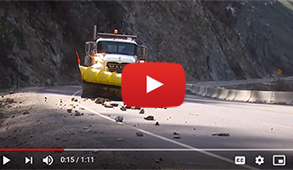
Typically, larger commercial vehicles are limited to a lower speed and axle weight.
When subjected to high speeds and heavy loads, soft spots begin to wear, eventually breaking up and creating potholes.
Motorists are urged to be patient when traveling on highways where limitations have been placed.
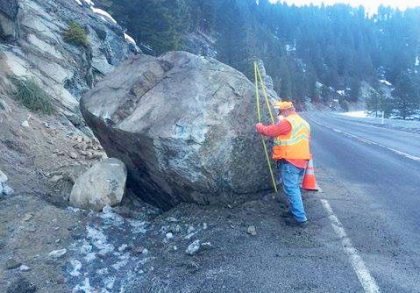 There’s nothing like a car-sized boulder resting in the middle of a highway to wreak havoc with your highway travels. Driving has its share of inherent risks, but ITD wants to do everything possible to narrow down the list of hazards.
There’s nothing like a car-sized boulder resting in the middle of a highway to wreak havoc with your highway travels. Driving has its share of inherent risks, but ITD wants to do everything possible to narrow down the list of hazards.
Every year, the potential exists for rockfall. If there’s moisture in the air, chances are pretty good there will eventually be rocks that tumble down to the road below. This is because when hillside soils get saturated by that moisture, they start to give way and can no longer hold back the rocks embedded in those soils. Precipitation in the form of snow, rain or even fog with a high moisture content increase the chances of a slide.
Not everyone will be like the massive landslide near Elk City in 2016, but it is a stark reminder of the dangers posed this time of year.
These events demonstrate an increased likelihood of rocks and debris releasing from hillsides each spring, especially for highways bordered closely by steep hillsides or mountains.
“Many of Idaho’s highways cut through forests and along steep slopes,” said ITD Emergency Program Supervisor Neal Murphy. “In the spring, when soils are saturated, the risk of falling debris is significantly higher. That is especially true in forests that have experienced recent fire or in mountainous terrain that is vulnerable to avalanches.”
The Idaho Transportation Department reminds drivers to plan ahead and check the 5-1-1 traveler advisory system (via phone or web) before heading out, especially to the mountains.
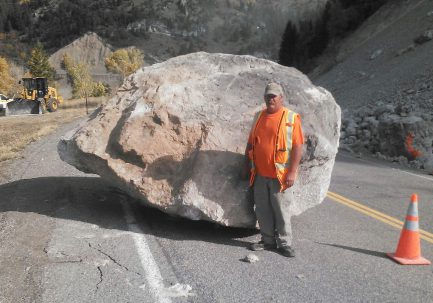 In the event of a slide or rocks on the road, drivers are asked pull onto the shoulder, turn emergency flashers on, and call local law enforcement, the local ITD office or nearest maintenance facility with a location description or milepost. Remain in the vehicle until help arrives.
In the event of a slide or rocks on the road, drivers are asked pull onto the shoulder, turn emergency flashers on, and call local law enforcement, the local ITD office or nearest maintenance facility with a location description or milepost. Remain in the vehicle until help arrives.
The landslide west of Elk City carried about 235,000 cubic yards of material – 47 million lbs. – down to the highway. The biggest boulder near Smiths Ferry was estimated at 29 tons. While those are staggering numbers, even much smaller debris could derail a motorcyclist or bicyclist.
A recent spring was highlighted by a 50-ton boulder coming down the hill on Warm Springs in Boise, a rockslide on Idaho Highway 97 in northern Idaho that carried an estimated 450 tons of debris, a huge boulder on Idaho Highway 55 at Smiths Ferry (above photo), and this massive boulder in eastern Idaho.
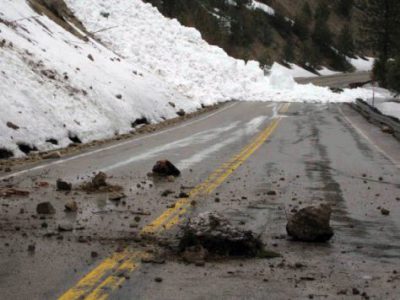 Spring snow conditions can be deceptive. While the air may feel warmer and thoughts turn to spring, often conditions are ripe for a springtime slide.
Spring snow conditions can be deceptive. While the air may feel warmer and thoughts turn to spring, often conditions are ripe for a springtime slide.
Our ITD avalanche forecasting crew remains busy into the spring, monitoring avalanche conditions. Even in years with less snowpack, warmer weather creates higher avalanche danger. It can be a time of high volatility from loose, wet snow. Spring can also hold avalanche hazards not encountered during the colder parts of winter. Snowpack and weather transitioning into a warmer and wetter spring pattern can result in snow instability.
Due to this risk, our avalanche crew continues to actively monitor snow pack and evaluate weather conditions outside of the traditional winter months. Their assessment guides decisions related to keeping motorists and our road crews safe.
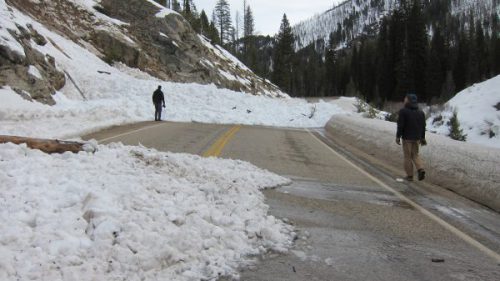 ITD encourages anyone that lives, works or travels through our state’s avalanche zones to visit 511.idaho.gov before you head out. It provides updated traveler conditions, information on potential closures or other hazards.
ITD encourages anyone that lives, works or travels through our state’s avalanche zones to visit 511.idaho.gov before you head out. It provides updated traveler conditions, information on potential closures or other hazards.
Vegetation


Noxious weeds are spreading at an alarming rate across the Western United States. Each year approximately $23 billion is lost nationwide due to invasive plant impacts to agriculture, industry, recreation, and the environment. In addition, invasive plants are invading about 4,600 acres of land daily with over 8 million acres of Idaho lands severely infested by one of the 35 state-designated noxious weeds.
ITD Integrated Vegetative Management (IVM) program applies specific guidelines and complies with federal, state and local noxious weed laws to effectively eliminate, control and manage the spread of noxious weeds.
ITD is currently using environmentally beneficial landscaping which includes utilizing techniques that compliment and enhance the local environment and seek to minimize the adverse effects that landscaping has on it. It also provides a framework for preventing the introduction of and controlling the spread of invasive plant species on highway rights-of-way.
Some of these techniques and equipment include selective herbicide applications, brush control or removal, promoting native or adaptable vegetation, reseeding disturbed areas, bio-control agents and delivery systems, more efficient equipment cleaners, improved seeding equipment (for steep slopes), Global Positioning System (GPS) for invasive population inventories, and methods to minimize soil disturbance during vegetation management activities.
- State of Idaho’s Noxious Weed Program
- Idaho Rules governing Invasive Species & Noxious Weeds
- Idaho Weed Awareness
- Idaho Invasive Species Program
- Federal Highway Administration Invasive Species
- National Invasive Species Program
- Executive Order 13751
- Environmental Review Toolkit | Roadside Use of Native Plants
- Roadside Invasives
- Aquatic Invasive Species
- Transporting a Boat | Watercraft Inspection
- Idaho Watercraft Inspection Stations Dashboard
For additional information, contact Cathy Ford, Roadside Programs Coordinator, at 208-334-8416.

Wildflowers and other native plants provide visual character that enhances the natural scenic beauty of our state’s landscape. The growing concern for our natural heritage has generated an increasing interest in their restoration, preservation, and appreciation.
Our highways provide access to the splendors of nature as well as offer opportunities for natural beauty within their rights-of-way. The “Operation Wildflower” program and the Surface Transportation and Uniform Relocation Assistance Act of 1987 (STURAA) initiated the use of native wildflowers and other native vegetation along the rights-of-way to add natural character and diversity to the highway environment. These programs are the framework of Idaho Transportation Department’s wildflower and native habitat restoration programs.
Resource Site: ITD Roadside Vegetation Guide | Seed mixes & pollinator resources
Since 2001, ITD’s native plant program has reintroduced native species to thousands of road miles and incorporated native species into seed mixes and revegetation activities. Using native plants enhances biodiversity, preserves natural habitats, and restores native wildlife habitats.
Transportation planning and project development must reflect the desires of communities, and take into account the impacts on both the natural and human environments. Transportation projects are closely looked at to see how they might impact the community, the natural environment, and our health and welfare.
- The Natural Resources Conservation Service Plant Database
- FHWA’s Roadside Use of Native Plants
- FHWA’s Ecosystems & Vegetation Management
For additional information, contact Cathy Ford, Roadside Programs Coordinator, at 208-334-8416.

ITD supports research, development, and technology transfer activities addressing the Department’s strategic goals and initiatives. It is ITD’s mission to develop and maintain effective partnerships, deliver efficient and effective transportation services, offer practical solutions for immediate and long-term problems, develop new tools/technologies and facilitate their implementation, and coordinate projects performed by universities and agencies.
Roadside research focuses on balancing concerns for natural habitats and environments while enhancing roadside vegetation communities. It is a comprehensive program that focuses on improving the quality of natural environment by reducing noxious and invasive species establishment and spread, reducing wind and soil erosion, improving slope stability, establishing sustainable native vegetation, restoring natural habitats, and protecting and enhancing ecosystems. Research initiatives support statewide planning and involvement with the environmental process, construction activities, and maintenance operations.
Partnerships are essential to an efficient and effective integrated roadside vegetation program. Partnership projects help reduce soil erosion, increase wildlife habitat, and reduce damages caused by invasive species, wildland fires and other natural disasters. Public benefits include enhanced natural resources that help sustain environmental quality while supporting continued economic development, recreation, and natural beauty.
Bureau of Land Management
The I-84 Hazardous Fuels project was initiated between the Bureau of Land Management (BLM) and Idaho Transportation Department (ITD) in 2005 to implement fire management approaches to reduce the impact of devastating wildfires that have plagued the western U.S. for many years. The objective of the project is to increase public safety, improve the condition of natural resources on public lands by decreasing the number of fire starts originating from the I-84 transportation corridor, and decrease the spread and frequency of fires moving from the interstate onto adjacent public lands and into urban communities and sprawling home development.
Tri-State Cooperative Weed Management
The Tri-State project was initiated between WSDOT, MDOT, & ITD in 2006 to evaluate and implement noxious weed management strategies along the I-90 corridor stretching from Washington to Montana. The objective of the project is to implement a weed management plan and strategy for notifying agencies of new invaders, reduce economical impacts of new invaders, identify and stop the spread of new invaders across borders, educate the public and stakeholders on prevention and response measures, and increase awareness and communication.
Native Plant Research
- RP171 Vegetation Management Practices
- RP171 Roadside Vegetation
- RP192
- RP291 Bees & Butterflies in Roadside Habitats
Integrated Erosion Control Methods
Integrated Vegetation Management
Winter Driving
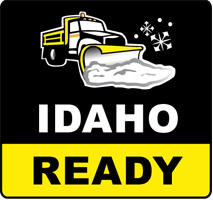 IDAHO READY | Winter Safety Campaign
IDAHO READY | Winter Safety Campaign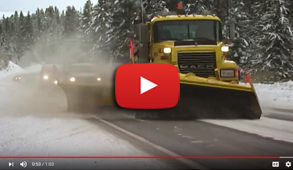
Be prepared and stay safe with information for driving during the winter months.
Winter Driving Checklist
For Idaho motorists, winter driving is a necessity. Drivers can help ensure safer travel by preparing themselves and their vehicles for the cooler months ahead.
- IDAHO READY Blog Post: Before you go, don’t forget to pack your winter car emergency kit
- VIDEO: Winter-time Vehicle Maintenance
Even the most cautious driver should carry some essential items in the car in case of an emergency. Use a plastic crate or a large, heavy canvas bag to store the following items in the trunk of your car: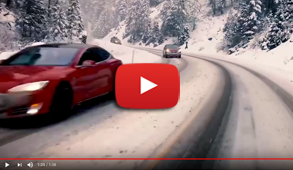
- Flashlights with extra batteries
- First aid kit with a pocket knife
- At least one blanket
- Extra set of mittens, socks and a wool cap
- Small sack of sand or cat litter for generating traction under the wheels
- A small shovel
- Bottled water
- Jumper cables
- Window washer solvent
- Ice scraper with brush
- Cloth or roll of paper towels
- Warning devices (flares or triangles)
- Basic toolkit (screwdrivers, pliers, adjustable wrench)
- Mobile phone and car charger pre-programmed with rescue apps and important phone numbers including family and emergency services
- Non-perishable snacks for both human and pet passengers
- Canned fruit, nuts and a non-electric can opener
Winter Car Care Checklist
A winter car kit helps ensure a driver’s safety, but vehicles also need attention at the start of the winter season. The American Automobile Association (AAA) advises drivers prepare their vehicles for the winter season:
- Battery and Charging System – Have the battery and charging system tested by a trained technician. A fully charged battery in good condition is required to start an engine in cold weather.
- Battery Cables and Terminals – Make sure the battery terminals and cable ends are free from corrosion, and the connections are tight.
- Drive Belts – Inspect the underside of accessory drive belts for cracks or fraying. Many newer multi-rib “serpentine” belts are made of materials that do not show obvious signs of wear; replace these belts at 60,000-mile intervals.
- Engine Hoses – Inspect cooling system hoses for leaks, cracks or loose clamps. Also, squeeze the hoses and replace any that are brittle or excessively spongy feeling.
- Tire Type and Tread – In areas with heavy winter weather, installing snow tires on all four wheels will provide the best winter traction. All-season tires work well in light to moderate snow conditions, provided they have adequate tread depth. Replace any tire that has less than 3/32-inches of tread. Uneven tire wear can indicate misalignment, or wheel balance/suspension problems that must be addressed to prevent further tire damage.
- Tire Pressure – Check tire inflation pressure more frequently in fall and winter. As the average temperature drops, so will tire pressures – typically by 1 PSI for every 10 degrees Fahrenheit. The proper tire pressure levels can be in the owner’s manual or on a sticker typically located on the driver’s side door jamb. Also, check the spare.
- Air Filter – Check the engine air filter by holding it up to a 60-watt light bulb. If light can be seen through much of the filter, it is still clean enough to work effectively. However, if light is blocked by most of the filter, replace it.
- Coolant Levels – Check the coolant level in the overflow tank when the engine is cold. If the level is low, add a 50/50 solution of coolant and water to maintain the necessary antifreeze capability. Test the antifreeze protection level with an inexpensive tester available at any auto parts store.
- Lights – Check the operation of all headlights, taillights, brake lights, turn signals, emergency flashers, and back-up lights. Replace any burnt out bulbs.
- Wiper Blades – The blades should completely clear the glass with each swipe. Replace any blade that leaves streaks or misses spots. In areas with snow, consider installing winter wiper blades that wrap the blade frame in a rubber boot to reduce ice and snow buildup that can prevent good contact between the blade and the glass.
- Washer Fluid – Fill the windshield washer fluid reservoir with a winter cleaning solution that has antifreeze components to prevent freezing.
- Brakes – If there is any indication of a brake problem, have the system inspected by a certified technician to ensure all components are in good working order.
- Transmission, Brake and Power Steering Fluids – Check all fluids to ensure they are at or above the minimum safe levels.
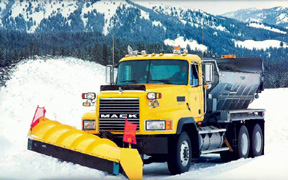
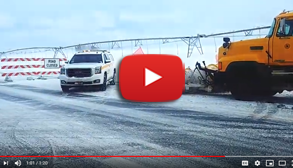
How does ITD prepare for the snow and ice season?
During the year, more than 400 ITD operations personnel prepare for the snow season by stockpiling necessary supplies. In the fall, the same trucks that have been used during the summer for stockpiling, patching and other maintenance operations are equipped with snowplows. Employees also receive training to operate new equipment.
How does ITD decide which roads to clear first?
ITD considers these factors for clearing roads in the state highway system:
- Traffic volumes
- Accident reduction
- Number of steep grades, sharp curves, intersections, ramps or potentially hazardous areas
- Availability of manpower and equipment resources
ITD applies liquid anti-icers to roads in many areas before a storm arrives. Once the anti-icing work is completed, ITD responds to winter storms as they occur and attempts to clear all roads as the snow begins to fall. However, in situations where a storm covers a large area, resources can be stretched beyond available limits. In these situations a system of priorities is followed to provide the best service.
- News Report: ITD prepares roads for snowstorm – Nov. 25, 2019
Interstates and state highways that have the highest volume of traffic are cleared first. Workers continue to clear roads with top priority placed on the most-traveled roads down to areas with lower volumes of traffic.
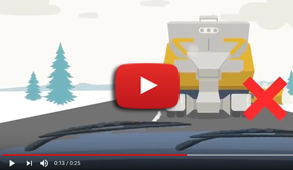
The winter maintenance priorities on the state highway system are approved by the Idaho Transportation Board.
How can drivers help when the roads are being cleared?

- Remain two car lengths behind snowplow trucks for every 10 mph you drive. Sand being spread by trucks can damage your vehicle.
- Do not pass a snowplow unless it is absolutely necessary. If you must pass, do so only when you can clearly see the road ahead. Do not pass on the side where the plow is spraying snow. If you do, the snow’s force can knock your car out of control.
- Do not cut back immediately in front of a snowplow truck. The plow blades are often covered with snow and can be difficult to see.
- Do not brake suddenly if you are traveling in front of a snowplow. The heavy vehicle cannot stop as quickly as an automobile.
- Do not abandon your car unless it is absolutely necessary. However, if you must, leave it as far off the road as possible. Abandoned cars can interfere with the road clearing process and can be extremely hazardous to snow removal equipment and the operators if they are hidden or buried by snow.
- Be aware of potential icy areas such as shady spots, bridges and overpasses. Since they are exposed on their undersides, bridges and overpasses are deprived of ground warmth and freeze more rapidly than the roadways leading to them.
- Before you begin your trip, make sure your car’s windows, mirrors and lights are clear of snow. Keep your windshield washers filled with a non-freezing solution all winter.
- Keep an emergency winter driving kit in your car. The kit should include: flashlights with extra batteries, a first aid kit with a pocket knife, at least one blanket, an extra set of mittens, socks and a wool cap, a small sack of sand or cat litter for generating traction under the wheels, a small shovel, bottled water, booster cables, canned fruit, nuts and a non-electric can opener.
- Travel Smart. Travel Safe. Get updates on winter road and weather conditions, emergency closures and access to tourist information 24-hours-a-day by visiting 511.idaho.gov or dialing 511. If your phone company does not support 511, simply call 888-IDA-ROAD (888-432-7623) to access the 511 system.
What should be done if a medical emergency occurs in an area where the roads have not been cleared?
In case of medical emergencies in areas where roads have not been plowed, the local or state police should be called. These agencies will work with search and rescue personnel and ITD to respond to emergencies.
• VIDEO: Safety around Snow Plows
• VIDEO: “Winter is here” (ITD Facebook Event)
Facts about Anti-Icing
Why do workers spray liquid onto the roadways before a big storm arrives? If you live in Idaho, you’ve probably asked yourself that question. It may seem dangerous to add liquid to a road that might freeze, but that liquid can be your best friend when winter driving conditions are at their worst. That liquid can prevent snow from sticking to the road and prevent frost or black ice. It’s one of the newest weapons against icy roads. Thanks to anti-icing, winter driving can be a safer experience. The following commonly-asked questions and answers will help you learn more about liquid anti-icing and the benefits it can offer motorists.
What is Anti-Icing? 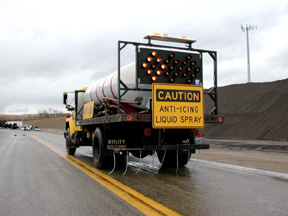
Liquid anti-icers work like anti-freeze by lowering the freezing temperature of water and preventing ice from forming a strong bond to the road. They help keep roads from becoming slick, improve safety and reduce accidents. Anti-icing liquids are less toxic than baking soda or salt. Unlike sand, it won’t crack your windshield or chip your car’s paint.
What can I do if I drive on roads where Anti-Icing liquids are used?
Wash your car on a regular basis. Anti-icing liquids (along with slush and dirt from the roads) can splash onto your car and build up after time, leaving a filmy residue on your car. Make car washing part of your regular maintenance routine, and you’ll help keep residue from the winter roads off of your car.
Why not use sand?
In many cases anti-icing liquids work better than sand. They keep snow from firmly sticking to the pavement. Anti-Icing liquids also last longer than sand and work in a broader range of conditions. Sand can be crushed by traffic and produce airborne dust, which contributes to pollution. Because sand is easily blown off the road by traffic, it requires repeated applications.
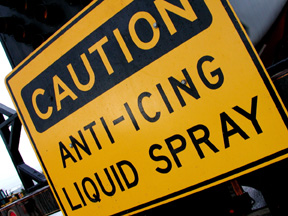 How are Anti-Icing liquids used?
How are Anti-Icing liquids used?
Anti-icing: A light application of the liquid is made to a road before a storm to prevent a hard bond of ice, reduce snow buildup and speed snow and ice breakup after the storm.
De-icing: The liquid is applied to remove a thin layer of snowpack or ice already on the road. It can be very effective for melting black ice and freezing rain.
Pre-wetting: Wetting traditional sanding material with anti-Icing causes sand to stick to snowpack better. Keeping sand on the road is nearly impossible in some circumstances, especially in very cold weather and in cases where there’s traffic at highway speeds. Anti-Icing liquids can keep the sand from blowing to the shoulder of the road.
What about cost?
Anti-icing liquids are usually the most cost-effective alternative when considering the whole picture. There are less expensive chemicals to use for snow and ice control, such as salt and other ice melting chemicals. But those alternatives can be harmful to vehicles, bridges and the environment.
Anti-icing liquids are a good alternative because they are less corrosive and work better than other chemicals. They reduce environmental impact, bridge corrosion and vehicle damage.
In the last few years Idaho has worked with Montana, Washington, Oregon, Colorado and British Columbia to develop higher standards for a winter maintenance chemicals. The goal among the six transportation regions is to use a winter maintenance chemical that is appropriate for our environment and less corrosive than other alternatives.
For more information, contact Ty Winther, Maintenance Services Coordinator, at 334-8413.
How does the Idaho Transportation Department (ITD) keep highways clear in the winter?
 ITD monitors the weather to determine when to use which applications on our roads to keep them safe. ITD uses anti-icing applications such as liquid salt brine and magnesium chloride before the storm hits to prevent ice from forming. During the storm, ITD plows the roads and applies de-icing solutions to remove snow from the road.
ITD monitors the weather to determine when to use which applications on our roads to keep them safe. ITD uses anti-icing applications such as liquid salt brine and magnesium chloride before the storm hits to prevent ice from forming. During the storm, ITD plows the roads and applies de-icing solutions to remove snow from the road.
- Summary Sheet: Salt and Idaho Roads
Why do we use salt in winter road maintenance?
Salt is extremely effective at keeping roads free of ice and snow. It improves safety and mobility on Idaho’s roads, and saves lives in the process by reducing crashes. We recognize the need to continuously improve salt-management practices, and we continue working to minimize wildlife or environmental impacts and the corrosion of vehicles on the road. ITD’s commitment to serving the public and keeping commuters safe will always remain our top priority.
ITD’s winter road-clearing practices save lives: Roadway safety and mobility benefits of bare, ice-free highways cannot be disputed. Fatal and serious-injury crashes have declined significantly during the last decade, corresponding directly to ITD’s increased salt usage. Annually between 2011-2018, fatal crashes have dropped from 15 to 4 in adverse winter conditions on state highways, and serious-injury crashes from 69 to 19 in that same time period. Overall, crashes have been drastically reduced, from 1,966 to 633. The data shows we are saving lives through effcient, effective winter road maintenance. The key is using the right product for the right place at the right time. We use a Mobility Cost Efficiency index to move toward that goal.
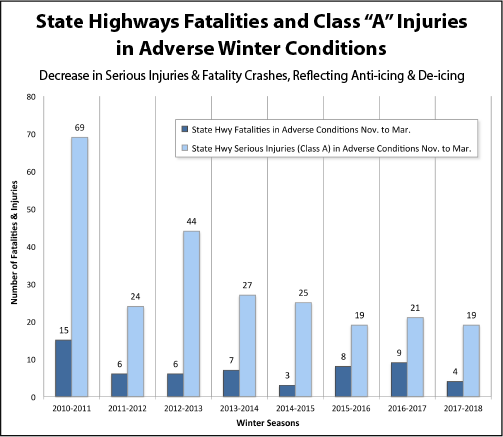
What Idahoans say: In the most recent survey of road users in Idaho (2014), 99.3% of people said ITD should maintain or increase winter maintenance efforts. Nearly 80% said they felt safe on Idaho highways during the winter, almost 76% said they are somewhat satisfied or very satisfied by our level of maintenance. The overwhelming majority of drivers were most comfortable with a “Bare Pavement” approach, which is achieved through the use of salt or salt products, not by plowing snow or sanding alone. Our practices reflect what drivers want, along with Roadway Salt Best Management Practices (2015) from Clear Roads — a coalition of 36 “snowbelt” states — and a salt study commissioned by ITD in 2014 that verifies salt as the best option for safe winter operations.
How do we decide what to use?
ITD actively looks to lessen the use of salt products while still getting the job done. The decision on what product to use is up to each foreman for the roads they keep clear. It may vary within the same region, as topography, road geometry, elevation or weather characteristics change from one place to the next.
Effectiveness in the conditions the product is used is the most important factor. We also consider what is available at the time of need. Cost alone should not be the final determination. Safety is the top priority.
While some in the public want us to use more sand on the roads, sand has a negative environmental impact on air quality as dust is spread upward. Sand also creates drainage issues as it builds up in streambeds and spawning beds.
Background: ITD began decreasing sand use in the early 2000’s because using sand alone wasn’t providing the desired results.
Since 2010, ITD’s mobility index (the percentage of time during winter storms that Idaho’s state roads are clear and passable) has increased from 28% to 86%. This directly correlates to the effcient movement of goods and services.
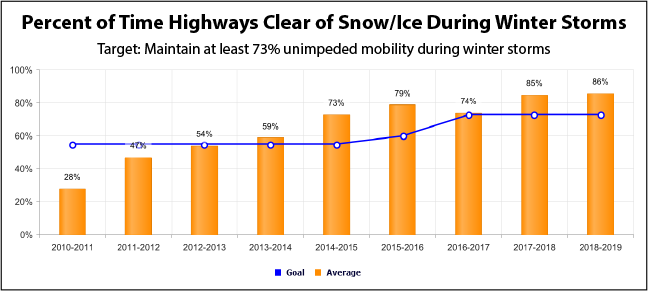
ITD is nationally recognized for the success of its winter maintenance program, which prioritizes the safety of the traveling public. A number of states and more than a dozen other countries have contacted ITD about our winter road performance program. Clear Roads, Intelligent Transportation Systems International, the Federal Highway Administration and “Roads and Bridges” magazine have all written articles on ITD’s winter road maintenance program.
The department won an award from the American Association of State Highway Officials (AASHTO) — the nation’s highways group — for the winter-performance measuring system in 2013, and for the winter mobility indexing the following year.
In the 18-state western state coalition called WASHTO (the Western Association of State and Highway Transportation Officials), 90% of the states use salt (along with snow plowing) as their primary winter road treatment method. ITD is constantly evaluating and improving our winter road-clearing practices and optimizing our mobility cost efficiency.
- White Paper: Use of Salt
- VIDEO: “What ITD uses on Idaho roads and why” (ITD Facebook Event)
Vehicle-corrosion issues
A result of using salts to maximize safety on the highways is vehicle corrosion, particularly the undercarriage. It has been a problem for many decades, with various solutions suggested.
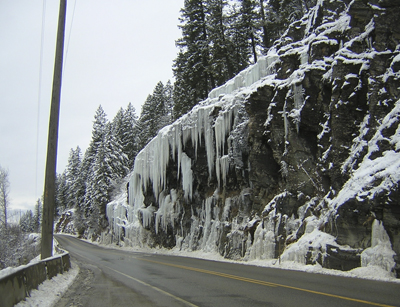 ITD uses sodium chloride salt, which is corrosive to iron and steel but has less impact on aluminum and copper. Transportation agencies also have experimented with buffering agents added into the salt. For liquid applications, the amount placed on the roadway varies with the purpose of the application. For anti-icing applications, liquids are applied just before the storm. For solid applications, ITD applies salt behind the snowplow to help melt the remaining snow and ice.
ITD uses sodium chloride salt, which is corrosive to iron and steel but has less impact on aluminum and copper. Transportation agencies also have experimented with buffering agents added into the salt. For liquid applications, the amount placed on the roadway varies with the purpose of the application. For anti-icing applications, liquids are applied just before the storm. For solid applications, ITD applies salt behind the snowplow to help melt the remaining snow and ice.
The best method to minimize corrosion available today is the careful use of salt. The application rates used by ITD are far below that commonly used in the Mid-Western States. At ITD, we take advantage of lessons learned, and have found that we can be very effective with far less material. In some of the areas of the state, such as northern Idaho, the weather is more temperate, with heavy, wet snow that works the best with the salt program.
Washing vehicles frequently will help minimize corrosion.
Salt keeps our roads safe, but it can build up on our vehicles, especially the undercarriage, and may cause damage to the underside of cars. It is important to prevent buildup by washing your car often during the winter months, preferably every week. If you go to a car wash, select an option that cleans the underside of your car. If you go to a carwash that only has wands, try to pay special attention to the wheels.
Salt for Safety
Remember, ITD uses salt on the road to keep them as safe and clear as possible, and only uses as much salt as necessary to do the job. Please remember to clean your vehicle during the winter months, and call 5-1-1 or visit 511.Idaho.gov for the latest conditions on Idaho highways.
Studded snow tires are legal in Idaho from Oct. 1 to April 30
Snowstorms may not be part of the immediate weather forecast, but Oct. 1 marks the date for legal use of studded snow tires in Idaho.
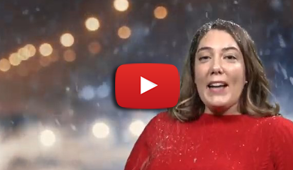
While it may be legal to use the tires, officials advise against it unless conditions warrant. Studded tires are snow tires with small metal cleats embedded in the tread, and may cause undue wear on bare roadways. Idaho’s studded snow tire season continues through April 30.
Studded tire laws vary in neighboring states:
- Montana: Oct. 1 – May 31
- Nevada: Oct. 1 – April 30
- Utah: Oct. 15 – April 15
- Oregon: Nov. 1 – March 31
- Washington: Nov. 1 – March 31
- Wyoming: Legal all year
For weekly updates on highway construction projects in Idaho, call the Idaho Road Report at 511 or 1-888-IDA-ROAD (432-7623). For online updates, visit the transportation department’s road report at 511.idaho.gov. Daily reports on winter road conditions are provided from November through April.
ITD Contacts
Ty Winther| Maintenance Services Manager | 208-334-8413
Cathy Ford | Roadside Programs Manager | 208-334-8416
Judi Conner | Fuel Systems Manager | 208-334-8094
Mailing Address
Idaho Transportation Department (ITD)
Mobility Services – Maintenance
PO Box 7129 | Boise, Idaho 83707
Phone: 208-334-8400
Street Address
ITD – Mobility Services – Maintenance
3293 Jordan Street | Boise, Idaho 83703
Fax: 208-334-8595

